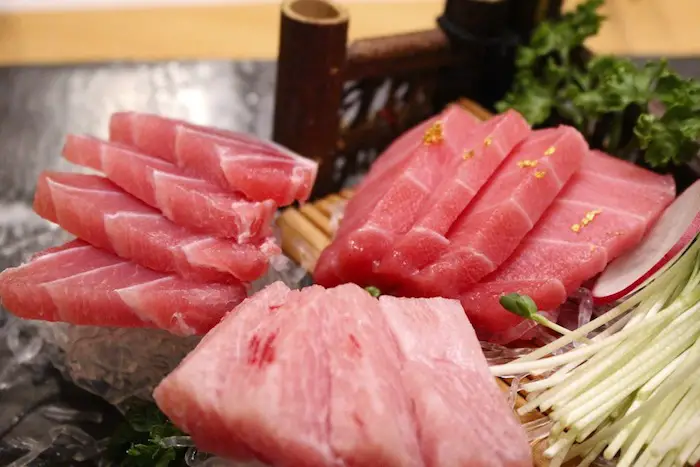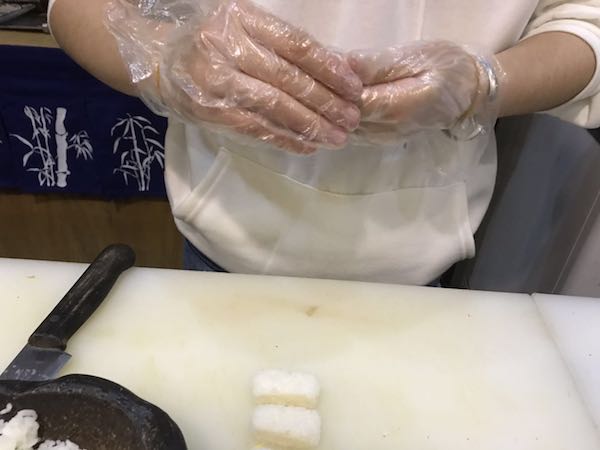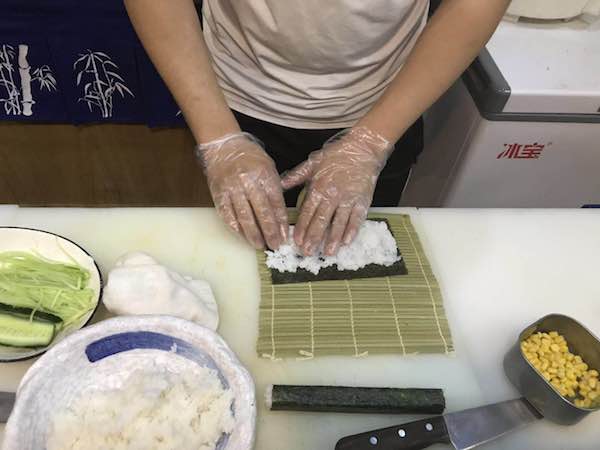We are reader supported. When you purchase through links on our site, we may earn an affiliate commission. Also, as an Amazon affiliate, we earn from qualifying purchases.

I am such a great fan of spicy tuna sushi that I can have it any time of the day, but the difference in tastes often bewildered me. It was then I discovered from a sushi chef that not all cuts of tuna are the same. They differ in looks, taste, flavor, quality, and of course price.
Today I will tell you what is toro and how to make toro sushi. Toro (pronounced as toh-roh) is the Japanese term used to indicate the fatty belly part of bluefin tuna fish, which is considered as a highly prized item in the menu.
The belly section of tuna is embedded with fat, hence toro feels buttery in the mouth and often has a marbled appearance. As this area of tuna fish (also known as maguro or hon-maguro in Japanese) is huge, it is often broken down into two subtypes – Otoro (oh-toh-roh) and Chutoro (choo-toh-roh).
You may find Otoro pieces in the supermarket labeled as o-toro and it is considered as the fattest section of the bluefin tuna. It is taken from the underside of the belly. The texture is so rich and buttery that it almost melts inside the mouth and feels like it could fall apart any moment.
Chutoro may be labeled as chu-toro in the grocery stores or supermarket. These pieces are taken from the belly portion along the sides of the fish, located between the otoro and akami. Health conscious sushi eaters often prefer this variety of tuna as it has a fatty texture but not as much as otoro.
Contents
What Are The Other Portions Of Tuna Flesh Called?
When you order tuna sushi in a restaurant, what you usually get is the akami (ah-kah-me). It is the leaner meat derived from the sides of the fish, not belly area.
It does not have a lot of fat content and the texture is less buttery when compared to otoro or chutoro. As a result, the price of sushi that contains akami is way less than the exclusive otoro sushi.
The highest quality akami is also known as Senaka, the medium quality is called sekami, while the lowest quality akami is often known as seshimo. If you are a fan of nigiri sushi, you should not miss the opportunity of enjoying it with the most exclusive cuts of bluefin tuna fish or toro maguro.
You may also enjoy the delicacy at home. Later in the article, I will show you how to make nigiri sushi using toro at home.
What Does Toro Taste And Look Like
Toro has a unique taste that impresses the tastebuds of most people who sample it and fall in love in their first experience. The fantastic sirloin feel of bluefin tuna blends beautifully with the fatty tissue from the belly area to form a rich and creamy texture that melts inside the mouth.
Toro is frequently used for making nigiri sushi in upscale sushi bars and restaurants for its exclusive combination and sophisticated taste. It may also be used to prepare seared tuna that has a rich texture and delectable taste.
If you haven’t tasted Otoro before then let me tell you that it almost feels like a stick of butter inside the mouth. As a first-time tuna belly meat eater, I would recommend that you first try the less overwhelming Chutoro which also has high-fat content but more red meat than Otoro.
The exclusive toro typically has a soft pink hue with clearly visible white lines due to fatty deposits. This marbled texture of the flesh is responsible for the distinct oily and creamy taste. To enjoy toro at its optimal flavor, it should always be consumed when it’s fresh.
For more information about tuna and How to Cut Tuna Loin for Sushi ( 金枪鱼寿司):
Toro Nigiri Sushi
Toro sushi is a prized item on the menu and most sushi restaurants sear the flesh by using a blow torch before using it in sushi. This helps in bringing out the umami flavors that are highly sought after by sushi eaters. The seared tuna fish feels more like a piece of marbled steak than fish.
What you will need:
- Cooked short grain sushi rice
- Sushi-grade toro (fatty tuna)
- Soy sauce
- wasabi
- Yuzu (lemon)
- Pickled ginger (gari)
Instructions
First, prepare perfectly cooked and seasoned sushi rice. To find detailed instructions for making sushi rice, check this article
Remove the skin of toro and trim the piece. Then you need to slice the toro and due to its high-fat content, we recommend using thin slices
Scrape off the meat on the skin and you use them for other delicacies.
Now, use a kitchen blow torch like this to sear the toro pieces and bring out the rich and delicious umami flavors.

Take a golfball size of sushi rice and use your right plam and fingers of your left hand to give an oval shape. Press gently using your thumb and middle finger to make a slight depression at the bottom and a hump on the top.
Place the seared toro over the bed of sushi rice and squeeze lemon on it to enhance the flavors. Press gently to ensure that the toro piece sits well on top of the rice bed.
Serve the nigiri sushi with soy sauce, wasabi, and pickled ginger. Learn how to make pickled ginger (gari) here.
Negitoro Sushi Recipe
What you will need
- Cooked and seasoned sushi rice
- 8 ounces Otoro, minced to form a paste
- 2 tsp sesame seeds
- 2 scallions finely minced
- Nori sheet
Instructions
Use short grain rice to cook sushi rice in a cooker or pot following the directions. When the rice cools, season it with vinegar, salt, and sugar. Read this article for step-by-step instructions.
Take a medium sized bowl and mix minced toro flesh with 3/4 of the finely chopped scallions. Add toasted sesame seeds to the mixture and stir well.
Keep a small bowl of water mixed with a few drops of vinegar o dip your fingers while making sushi to prevent the rice from sticking.

Now, lay the bamboo mat like this on a plain working surface and keep the nori sheet on it, shiny side down. Moisten your fingers and take a medium ball of rice. Flatten it over the nori sheet, pressing gently to make a homogenous layer.
Take a spoonful of the negitoro mix and arrange it on the edge of the rice, place it closer to you from one end.
Lift the bamboo mat from one side and start rolling, keeping the filling intact to form a compact roll. Don’t squeeze too much or the fillings won’t stay in their place.
When you reach the end of the Nori sheet, give one tight hug with the bamboo mat to give your roll a slightly square shape.
Take a sharp Japanese sushi knife and cut the roll into two from the midpoint, then cut each half into two pieces and further into two more pieces to have 8 segments in total.
Toro Green Onion Hand Sushi Rolls (Temaki)
Tuna fish and green onion make a great combination. Hence for this temaki or hand roll sushi, I use this classic combination. With fatty tuna or toro, you can take this temaki sushi to a different level altogether. Green onions help in enhancing the taste as well as adding to the texture.
What you will need:
- 1⁄2 sheet Nori
- Cooked and seasoned Sushi Rice
- Wasabi paste
- 1 strip fatty tuna or toro finely chopped
- 1 tbsp green onion thinly sliced
- 2 cups of water
Instructions
Cook sushi rice and season it with vinegar, sugar, and salt following the instructions mentioned here.
Take half Nori sheet and place it on the working surface

Take a small spoonful of rice and spread it on one corner of the seaweed , leaving 2/3 of the Nori empty
Add a few chopped pieces of toro over the sushi rice, close to the top
Now, sprinkle some finely sliced green onions over toro
Roll the Nori sheet to make a cone shape and seal the edges using a few grains of rice
Pro tips
- Make sure you roll the Nori snugly while making the hand roll, but be careful to not break the Nori sheet.
- You must ensure that our hands are dry before you start making a temaki roll to ensure that the nori remains crisp.
- Serve toro temaki or hand rolls immediately after making them or else they may turn soggy.
What’s The Right Method To Thaw Sushi-Grade Bluefin Tuna (Toro)
You can buy frozen sushi-grade Bluefin Tuna or toro from the grocery store but you need to take proper care while thawing it. First, you need to remove the plastic packaging as the product is vacuum-packed to keep it fresh.
Take a bowl and add lukewarm water with a temperature not more than 95° F. Now take some salt in a teaspoon and add to water. The ratio should be 1 tsp salt for one liter of water.
Take the toro fillet out of the packaging and hold it under running tap water to rinse it thoroughly and then immerse into the salt water solution.
Let the toro fillet sit in the warm water for about 3-5 minutes. Now, remove the fillet and rinse in cold water to remove any salt that may impact its original flavor.
Take a thin cheesecloth or sponge, wrap the filet in it to remove excess moisture. Now cover the toro pieces in a cheesecloth or dry sponge before wrapping it in cling film.
Make sure you do not wrap the toro too tightly because the fish needs to breathe. Now, store the fillet inside the refrigerator for 3-5 hours to let it breathe.
Related Questions
Why is toro sushi so expensive?
Toro is the most delicious and fatty part of tuna hence it’s rare and exclusive. Less than 1% of tuna flesh is categorized as toro. You won’t find many sushi restaurants serve toro sushi and those who do, the price is usually high.
How much does Toro cost
The price may vary depending upon the quality of toro, but roughly it will be around $8 to $15 per piece. The medium fatty toro or chutoro may be slightly less expensive than otoro.
Does toro sushi have more mercury than normal tuna sushi?
The report in this white paper says that there is less mercury in fatty tissues when compared to the fillet containing less fat. As toro comes from the bluefin tuna fish that lives longer than 15 years, the mercury levels in the fish may be higher than other varieties.
How is toro processed and shipped?
The high-grade toro comes from the fatty belly portion of tuna that has been meticulously processed to ensure that the flesh does not get bruised or harmed. When raw tuna arrives at the marketplace, a special instrument is used to sample the tissues for consistency and flavor prior to being valued.
What are the other species of tuna?
While different varieties of tuna can be derived from fish species such as bigeye and yellowtail, the finest quality of otoro is derived from bluefin tuna.
How long can you store raw toro
After raw toro is purchased it may be refrigerated for 1 to 2 days, however, it should be discarded if left outside at room temperature for more than 2 hours. You can extend the shelf life of toro by freezing it wrapped in an air-tight bag.
Can I store toro sushi in the refrigerator?
You may store toro sushi in the refrigerator for 24 hours but the sushi rice will turn bland and seaweed will become soggy. Hence, it is best to eat sushi immediately to enjoy the optimum flavors.

